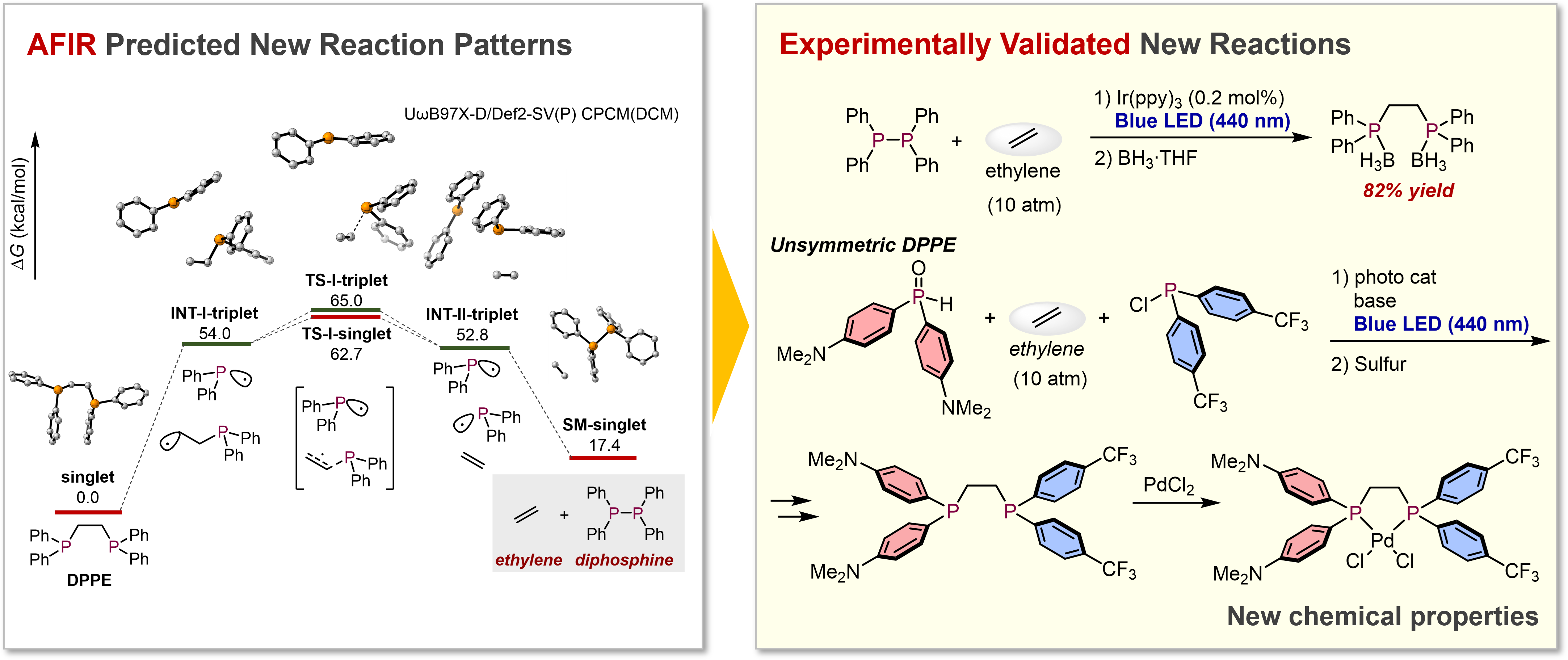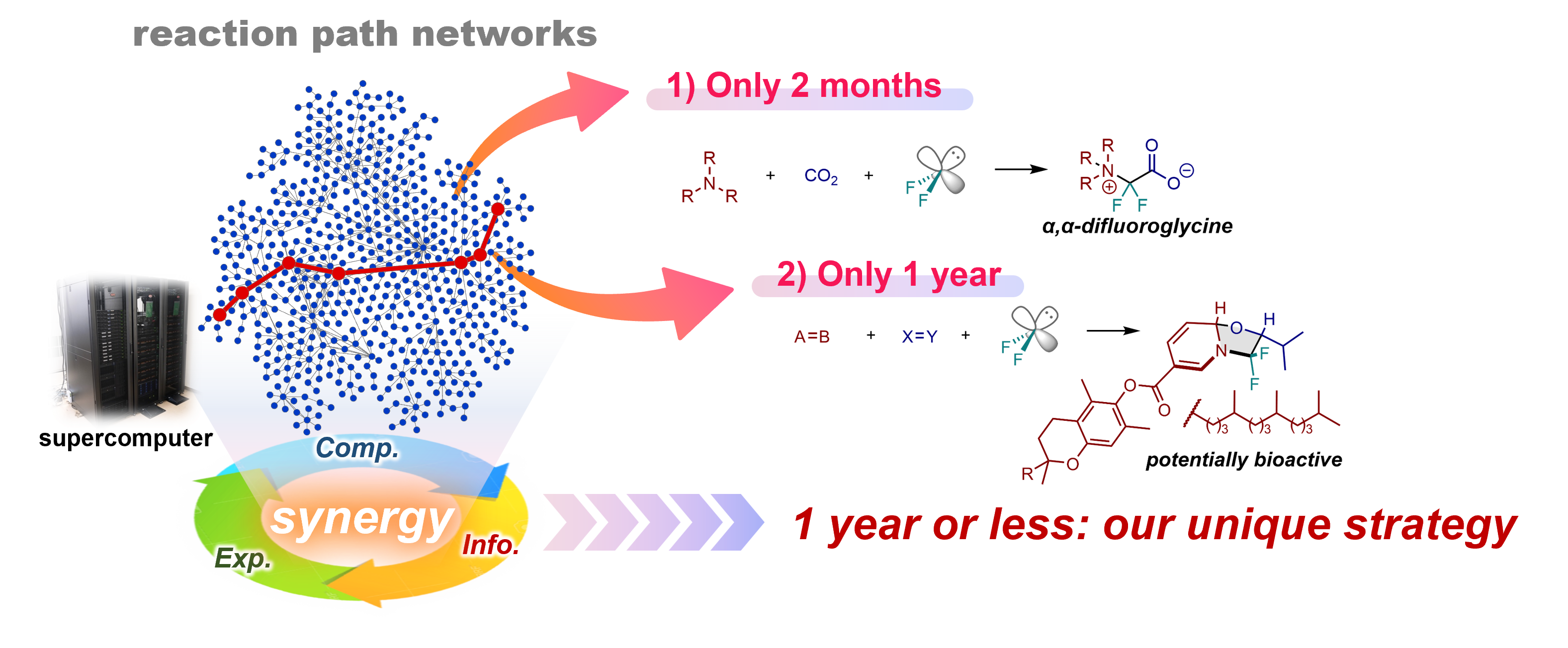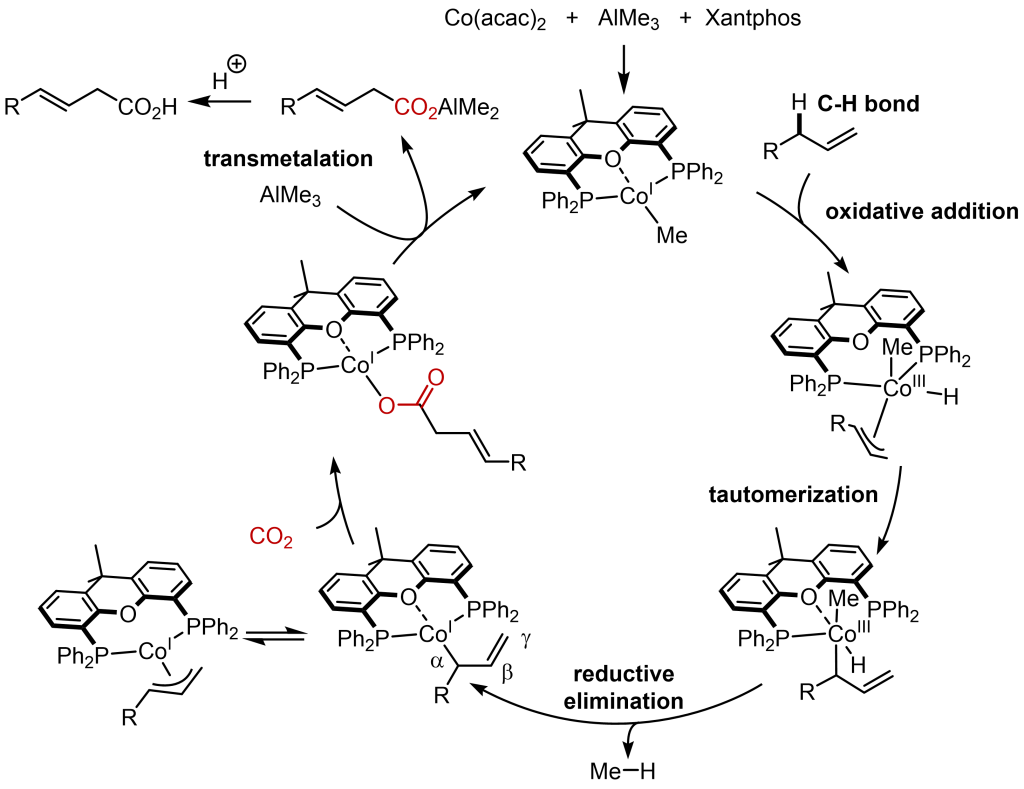1.1 Radical Reactions
 We are developing new radical reactions based on the reactivity of highly reactive radical species with seven valence electrons, estimated using quantum chemical calculations. To generate radical species, we utilize photocatalysts, electrochemical reaction devices, and a flow system that combines these methods. Our current research focuses on radical difunctionalization reactions of ethylene and radical fixation reactions of carbon dioxide (CO2). The transformations of inexpensive, abundant gaseous molecules into valuable compounds can contribute to the realization of a sustainable society.
We are developing new radical reactions based on the reactivity of highly reactive radical species with seven valence electrons, estimated using quantum chemical calculations. To generate radical species, we utilize photocatalysts, electrochemical reaction devices, and a flow system that combines these methods. Our current research focuses on radical difunctionalization reactions of ethylene and radical fixation reactions of carbon dioxide (CO2). The transformations of inexpensive, abundant gaseous molecules into valuable compounds can contribute to the realization of a sustainable society.
Press Release and Research Introduction Articles
- Press Release Development of a Novel Synthetic Method for Valuable β-Amino Acids: A Three-Stage Approach of Theory, Synthesis, and Process
- β-Amino Acid Synthesis Using the CO2 Radical Anion under Electrochemical and Photochemical Conditions
- Press Release Computationally guided development of an alkene aminocarboxylation with CO2: synthesis of a β-amino acid derivative
- Development of a new method for the chemical synthesis of diphosphine ligands from strained small molecules
- Method developed for synthesizing γ-lactones from allylic alcohols and formate salts under light irradiation
- Press Release Synthesis of bicyclo[1.1.1]pentane-based, straight-shaped diphosphine ligands
- Press Release It takes two: cooperating catalysts provide new route for utilizing formate salts
- Press Release Method for automated reaction path search of photoredox reactions enables determination of the Knowles hydroamination mechanism
- Spotlight Research Development of new reactions by merging computation and experiment: convenient synthesis of symmetrical and asymmetrical DPPE
- Press Release Simplified process shines light on new catalyst opportunities
- Press Release CO2 recycling and efficient drug development—tackling two problems with one reaction
- Computational-chemistry-guided development of the difunctionalization of ethylene gas: selective incorporation of two ethylene molecules
Representative papers
-
Computationally Guided Development of an Alkene Aminocarboxylation with CO2: Synthesis of a β-Amino Acid Derivative
Kanna, W.; Harabuchi, Y.; Tanaka, K., III; Hayashi, H.; Takano, H.; Kozuka, T.; Sakurai, H.; Mase, N.; Maeda, S.*; Mita, T.* ACS Catal. 2025, 15, 12180 - 12191.
DOI : 10.1021/acscatal.5c03580
-
β-Amino Acid Synthesis Using the CO2 Radical Anion under Electrochemical and Photochemical Conditions
Singh, T.; Ueno, Y.; Tanaka, K., III; Kanna, W.; Harabuchi, Y.; Maeda, S.*; Mita, T.* ChemistryEurope 2025, 3, e202500184.
DOI : 10.1002/ceur.202500184
-
Photoredox-Catalyst-Free Carboxylation of Unactivated Alkenes in DMSO: Synthesis of Polycyclic Indole Derivatives and Aliphatic Acids
Debbarma, S.; Hayashi, H.; Ueno, Y.; Kanna, W.; Tanaka, K., III; Mita, T.* Org. Lett. 2024, 26, 10897 - 10902.
-
Trans-Selective Carboxylative Cyclization of 1,6-Dienes Using the CO2 Radical Anion
Song, Y.; Hayashi, H.*; Mangaonkar, S. R.; Mita, T.* Chem. Lett. 2024, 53, upae149.
DOI : 10.1093/chemle/upae149
-
Strain-Releasing Ring-Opening Diphosphinations for the Synthesis of Diphosphine Ligands with Cyclic Backbones
Krishnan, C. G.; Takano, H.; Katsuyama, H.; Kanna, W.; Hayashi, H.; Mita, T.* JACS Au 2024, 4, 3777 - 3787.
DOI : 10.1021/jacsau.4c00347
-
γ-Butyrolactone Synthesis from Allylic Alcohols Using the CO2 Radical Anion
Mangaonkar, S. R.; Hayashi, H.; Kanna, W.; Debbarma, S.; Harabuchi, Y.; Maeda, S.*; Mita, T.* Precis. Chem. 2024, 2, 88 - 95.
DOI : 10.1021/prechem.3c00117
-
Synthesis of Bicyclo[1.1.1]pentane (BCP)-Based Straight-Shaped Diphosphine Ligands
Takano, H.; Katsuyama, H.; Hayashi, H.; Harukawa, M.; Tsurui, M.; Shoji, S.; Hasegawa, Y.; Maeda, S.; Mita, T.* Angew. Chem., Int. Ed. 2023, 62, e202303435.
DOI : 10.1002/anie.202303435
-
Oxidation and Reduction Pathways in the Knowles Hydroamination via a Photoredox-Catalyzed Radical Reaction
Harabuchi, Y.*; Hayashi, H.; Takano, H.; Mita, T.; Maeda, S.* Angew. Chem., Int. Ed. 2023, 62, e202211936.
DOI : 10.1002/anie.202211936
-
Photoredox/HAT-Catalyzed Dearomative Nucleophilic Addition of the CO2 Radical Anion to (Hetero)Aromatics
Mangaonkar, S. R.; Hayashi, H.; Takano, H.; Kanna, W.; Maeda, S.; Mita, T.* ACS Catal. 2023, 13, 2482 - 2488.
DOI : 10.1021/acscatal.2c06192
-
A Theory-Driven Synthesis of Symmetric and Unsymmetric 1,2-Bis(diphenylphosphino)ethane Analogues via Radical Difunctionalization of Ethylene
Takano, H.; Katsuyama, H.; Hayashi, H.; Kanna, W.; Harabuchi, Y.; Maeda, S.*; Mita, T.* Nat. Commun. 2022, 13, 7034.
-
Electrochemical Dearomative Dicarboxylation of Heterocycles with Highly Negative Reduction Potentials
You, Y.; Kanna, W.; Takano, H.; Hayashi, H.; Maeda, S.*; Mita, T.* J. Am. Chem. Soc. 2022, 144, 3685 - 3695.
DOI : 10.1021/jacs.1c13032
 We study reactions using highly reactive chemical species with six valence electrons that do not satisfy the octet rule, such as carbenes, nitrenes, benzynes, and carbocations. In this research program, we leverage an artificial force induced reaction method, which can automatically search for chemical reaction pathways using quantum chemical calculations. Based on this computation-based strategy, we have reported new methods to prepare difluoroglycine derivatives and fluorinated N-heterocycles using difluorocarbene as the active species.
We study reactions using highly reactive chemical species with six valence electrons that do not satisfy the octet rule, such as carbenes, nitrenes, benzynes, and carbocations. In this research program, we leverage an artificial force induced reaction method, which can automatically search for chemical reaction pathways using quantum chemical calculations. Based on this computation-based strategy, we have reported new methods to prepare difluoroglycine derivatives and fluorinated N-heterocycles using difluorocarbene as the active species.
 Pericyclic Reactions, processes with 100% atom efficiency, are ideally suited for reaction predictions in computational chemistry. Utilizing predictions based on the Woodward-Hoffmann rules, it opens the possibility of identifying unknown reaction modes. We are actively pursuing research to further develop these advancements.
Pericyclic Reactions, processes with 100% atom efficiency, are ideally suited for reaction predictions in computational chemistry. Utilizing predictions based on the Woodward-Hoffmann rules, it opens the possibility of identifying unknown reaction modes. We are actively pursuing research to further develop these advancements.





